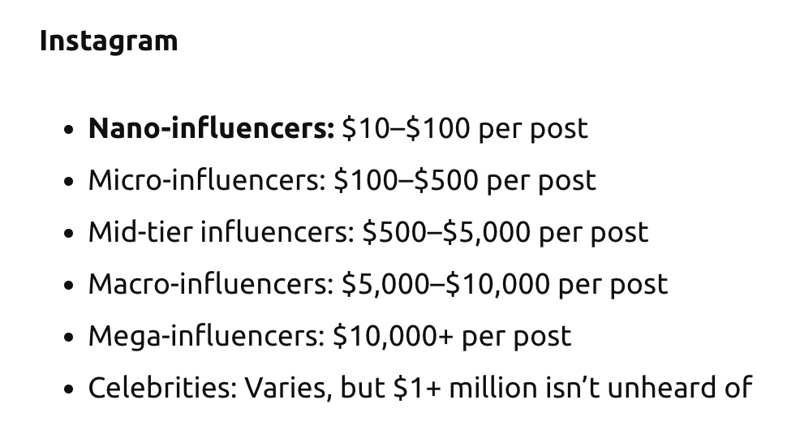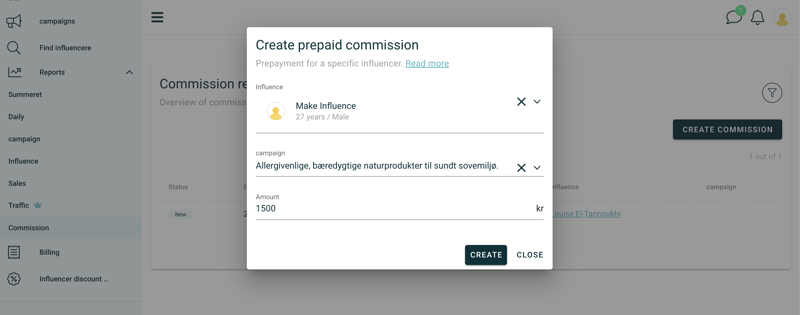“How should you pay influencers? And how much?”
These are probably THE two biggest questions ever to be faced within the influencer marketing industry.
At Make Influence, we have not failed to be vocal about our opinion, which some might consider controversial: influencer compensations should be tightly related to the results they generate for their collaborators.
There’s multiple reasons for our advocacy of performance based compensation, but surely the most important one is that it helps marketers building trust in the influencer medium. This is because of the familiarity of modern digital marketers with paying other channels based on CPC, CPL, CPA etc, as well as the necessity to make marketing decisions based on data, also when it comes to influencers.
As a result, more trust in the influencer as a powerful performance marketing medium, will translate into a more sustainable, long term industry growth benefiting all the players in it (influencers and marketers to begin with).
But... there is a but!
Compensation should be tightly related to performance, not necessarily exclusively dependent on it.
A budget for upfront payments, that is for paying an influencer a fixed sum, can open up a variety of opportunities for your brand.
In this article, you will learn how and when it is appropriate to consider paying an influencer a fixed sum, and how to create hybrid compensations models involving a mix of upfront and performance based payments.
- What are the reasons for paying upfront?
- What are the benefits of paying upfront?
- How much should I pay upfront?
What are the reasons for paying upfront?
The main reason is quite straightforward, and maybe also a bit of a cliche’: quality comes at a cost.
When you work with an experienced, professional influencer with a wide and engaged community, you are capitalising on years of work in building and engaging that community.
You would not pay the same amount for a young doctor straight out of uni and for a luminaire with a revered curriculum of successfully treating cases similar to yours. At least, I wouldn’t. 🤪
However, when it comes to influencer collaborations, establishing the quality in advance can be an ambiguous exercise, because of the many parameters to be taken in consideration and lack of data at your disposal to make an informed decision.
For example, a good set of questions to establish if you should pay an influencer upfront (and even if you should collaborate with them at all), might be the following:
- They have a wide and engaged community, but does it match with my target audience?
- They are great at promoting a similar products, but does their communication style match with my brand personality and image?
- They have strong beliefs that resonate with their audience, but are they a match with my company values?
If you have answered with a rock solid “YES” to all the previous questions, and you have proof that the influencer has a track record of delivering results that match your objectives (high number of impressions, super high click through rates or excellent conversion rates), then you should definitely consider setting aside an upfront budget for them.
I’m hearing you now, moaning about ”why paying upfront, if I can save money and just pay them based on results they generate?”.
Simple: It’s a matter of supply and demand, baby!
You’re not the only brand in your space doing influencer marketing, and the thing is, you’re competing for a scarce resource with many companies even outside of your competitive landscape. You might have the perception that influencers are an infinite resource, and you might be right, but good influencers that align perfectly with your brand are definitely not.
On top of this, influencers just have 24 hours a day like the rest of us to post on their channels, and good ones know there’s a limit to the amount of collaborations they can effectively manage and branded content they can push on their channels.
To sum it up: setting up a compelling compensation package, ideally made up by a fixed and variable (performance related) part for high quality influencers might be a very good idea to secure your competitiveness in the market!
What are the benefits of paying upfront?
We already touched upon one key benefit: setting aside a budget for upfront helps you ensuring you are competitive in front of very relevant and high quality influencers for your brand. If you use an influencer recruitment and campaign management tool like Make Influence, you will also be able to capture attention of influencers receiving a lot of inquiries by specifying your upfront budget in the campaign invitation, and overall make your campaign more appealing by communicating in your brief you are available to discuss upfront for very relevant candidates.
The second reason is slightly less obvious, but quite striking: an hybrid compensation model involving a mix of upfront and performance based can also increase ROI in the long term.
We have experienced this at Make Influence several times, when striving to secure long term collaborations with a few selected bigger influencers, the upfront part acts as a leverage for the company to demand the influencer positions the branded content in the most strategic way, while the performance related part incentivises the influencer to keep posting in the long run.
Finally, given you already have an established collaboration and a trustworthy relationship with a very high performance influencer, there could be an advantageous tradeoff in moving from a purely performance based model to a pure upfront model. In this case, the influencer might settle down for a lower upfront fee compared to what they would get if they were paid by commission, in exchange for being able to dispose of the money right away.
For example, an influencer that usually generates 50 sales a month worth 30€ for your brand (1500 euros) and getting a commission of 10% (150€ in commission paid each month), might decide to settle down to 120 or even 100€ upfront, giving you a higher ROI. Again, this is only advisable with those few, strategic influencers you trust and have a strong relationship with.
How much should I pay upfront?
Unfortunately, there is no definitive answer for this, and there never will be. There’s a few models out there to calculate influencer rate, the most famous one being the "1 dollar per 100 followers" one.
However, this model is highly debatable and has been used in very different ways by influencers and agencies all around the world, making it unreliable and obsolete in many cases.
The reason for the model being debatable is that upfront fees varies greatly based on different factors (size of the influencer, location of the influencer, channels presence, audience demographics, wether the influencer is managed by a talent agent or not, just to name a few). Sometimes, these factors are unfortunately completely arbitrary.
 Source: Influencer Marketing Hub
Source: Influencer Marketing HubTheoretically, for the exact same influencer, you could experience price differences even of up to 60% just because one influencer is independent and the other has an agency contract.
For this reason, if you are not new around here, you probably know by now that we highly recommend privileging a performance based model to an upfront model, especially for new collaborations with nano and micro influencers.
However, given the right conditions we highlighted above, providing a small upfront incentive could go a long way in helping you secure the best opportunities. At the same time, experimenting with progressively reducing commission in favour of higher upfront fees for influencers you have an successful history with, might prove a good choice for your long run ROI.
At Make Influence, we now support upfront payments, as well as Pay-Per-Click and Conversion Campaigns (pay a percentage of each sale generated).
You can read more about our campaign types, platform features, and use cases on our website... or you can discover the platform yourself, by booking a call demo meeting with our team!











Skriv en kommentar